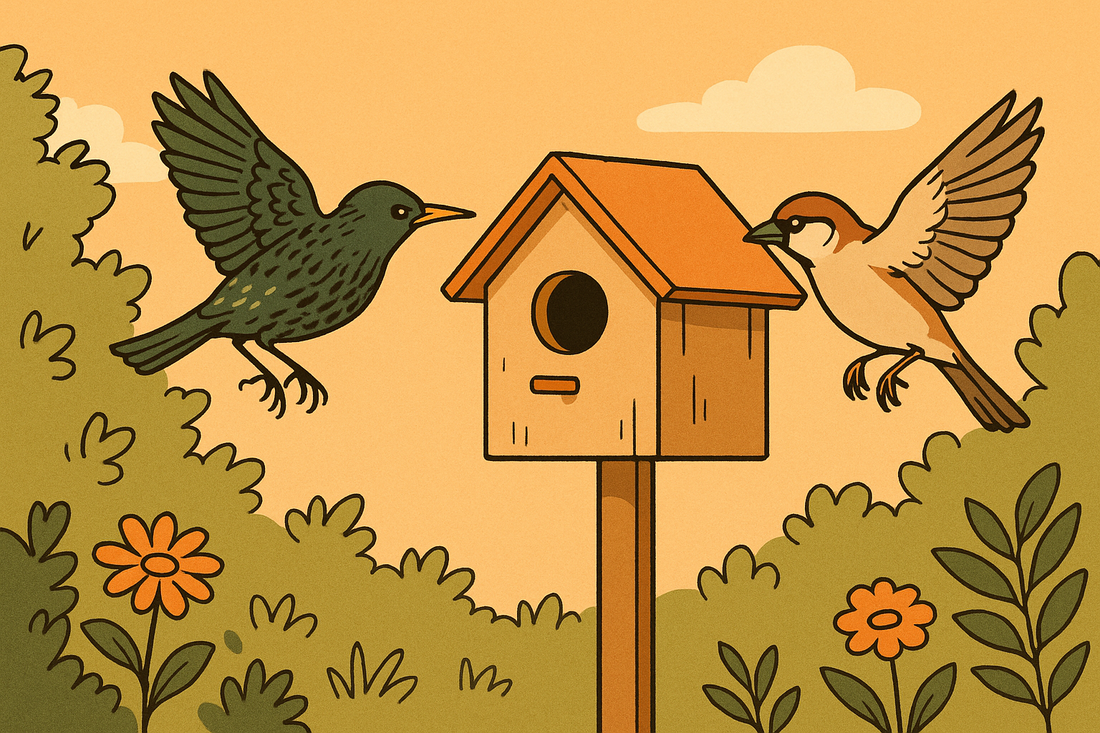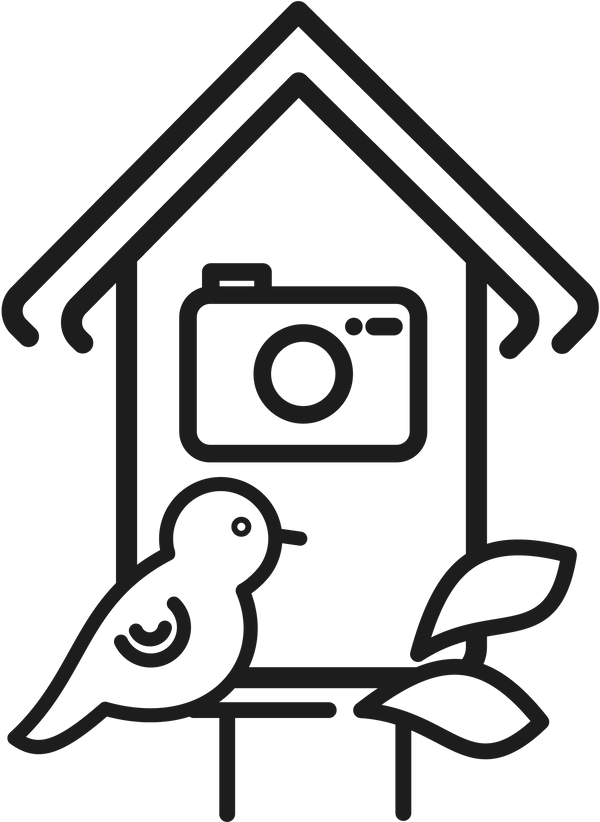
Nest box entrance hole with camera: 3.2 cm or 4.5 cm - which size suits which bird species?
The size of the entrance hole on a nesting box directly determines which bird species accept the box as a breeding site. For a nest box with a camera, which offers two interchangeable entrance hole rings with a diameter of 3.2 cm and 4.5 cm, the central question is therefore: Which size suits which species and situations? A hole that is too small excludes larger birds, while one that is too large increases competitive pressure and the risk of predation. In this article, you will learn how to use the ring size to promote species such as great tits, sparrows and starlings. You will also read how to choose the right mounting height, alignment and protection and how to use camera technology with minimal disruption. In this way, you can make an informed decision and support exactly the species that are native to your garden.
Why the size of the entrance hole determines the bird species
Bird species have species-specific body sizes - and the entrance hole acts as a "species filter". Smaller species get through small holes, while larger species need more space. For example, larger tits and sparrows typically use around 32 mm, while starlings need around 45 mm.
These sizes have been established in practical recommendations for years. NABU explicitly names 45 mm as the standard size for starling boxes, while 32 mm addresses many tits and sparrows in garden use (NABU: Starling box). The RSPB also lists 32 mm for Great Tit/House Sparrow and 45 mm for Starling (RSPB nest box tips).
For a nest box with a camera, the following also applies: Choose a quiet location and preferably observe via the stream. This will help you to avoid opening and disturbance during breeding. Cameras with infrared light and inconspicuous cabling enable observations without influencing the birds' behavior.
Comparison of 3.2 cm vs. 4.5 cm entrance hole rings
With two insert rings you can actively control which species can use the box. Below are the areas of application, advantages and disadvantages of both sizes - plus specific everyday scenarios to help you decide.
Ø 32 mm: The versatile garden bird standard

The 32 mm ring is the "all-round" choice for typical residential gardens. It is suitable for great tits, house and tree sparrows, nuthatches and pied flycatchers. Larger species are deliberately excluded - this reduces competition and can improve the breeding chances of smaller cavity-nesting birds.
Advantages: Broad species appeal in residential areas, natural protection from large competitors, slightly lower risk of predation at the flight hole. Note: Blue tits and other small tits prefer 26-28 mm, but sometimes use 32 mm if nothing smaller is available.
Practice: Would you like to encourage tits and sparrows in a residential garden? Start with 32 mm. If necessary, you can later equip individual boxes with reduction plates or smaller rings if you prefer to support smaller species.
Ø 45 mm: The "starling ring" for larger species

The 45 mm ring opens the box for starlings - the main target species of this size. In suitable habitats (orchards, open landscape edges), the rarer wryneck can also benefit. Smaller species can also use 45 mm, but are often displaced by starlings if they are present.
Disadvantages: Larger openings potentially encourage predation and widening by woodpeckers. Protective measures are particularly important here (metal perforated plate, sufficiently deep brood chamber, no "perching stalk").
Practice: Do you often have starlings in your garden or at the edge of an orchard? Choose 45 mm and hang several boxes at a slightly greater height. This supports colony breeding behavior and increases the chances of colonization.
Special case redstart: Prefers oval 48×32 mm instead of round. A 32 mm round hole is usually too narrow, 45 mm round is physically possible but not ideal. Special oval openings or half cavities are the better choice for this species (see NABU building instructions).
Decision in everyday scenarios:
- "Encourage tits in residential gardens": Select Ø 32 mm. Good chances for great tits, sparrows, nuthatches; blue tits often present anyway.
- "Starlings in orchards/edge of open land": Ø 45 mm, preferably several boxes, hang a little higher. Observe protective measures.
- "Enable a mix of species": Several boxes with different hole sizes, maintain minimum distances.
Typical users in Germany: 32 mm vs. 45 mm
The following lists are practical guidelines. Which species actually moves in depends on the habitat, food supply and local populations. Therefore, formulate expectations as "typical" rather than as a guarantee.
Ø 32 mm - typical users in DE
- Great Tit (Parus major) - Standard user for 32 mm, often in residential areas.
- House Sparrow (Passer domesticus) - "Sparrow", likes to nest close to humans, also in small groups.
- Tree sparrow (Passer montanus) - In semi-open landscapes and gardens with old trees.
- Nuthatch (Sitta europaea) - Fits through 32 mm; reduces openings with clay if necessary.
- Pied Flycatcher (Ficedula hypoleuca) - Migratory bird, takes 32 mm in locations close to the forest.
- Blue tit and other small tits - Prefer 26-28 mm, but occasionally use 32 mm.
Note: If you want to encourage smaller tits, smaller openings are ideal. With 32 mm, however, you can achieve the usual mix of species in the garden very reliably.
Ø 45 mm - typical users in DE
- Starling (Sturnus vulgaris) - Main target species, 45 mm standard size. Colony breeder, likes to hang a little higher.
- Wryneck (Jynx torquilla) - Locally possible, rather rare; benefits in structurally rich open land areas.
- Other possible users - Smaller species can also use 45 mm, but are often displaced by starlings.
Special case: redstart: Oval entrance hole 48×32 mm preferred. Special boxes are more suitable for this species than round 32/45 mm openings.
Location, height, orientation, protection: how it works in practice
Mounting height: 2-3 m is a proven height in gardens. Starling boxes like to be higher (3-5 m) if space permits.
Alignment: East/southeast is recommended. This way you avoid the weather side (west) and strong midday heat (south). This rule of thumb can be found in NABU guidelines (NABU BW: Hanging up).
Free approach: 1-2 m clear approach path in front of the hole. Avoid dense branches directly at the hole. Reduce climbing aids for predators.
No perching stalk: Not necessary and increases the risk of predators attaching. Good boxes deliberately do without them.
Distance from bottom edge of hole to floor: ≥ approx. 17 cm helps to thwart grasping attempts by paws and beaks. Make sure the brood chamber is sufficiently deep.
Weather protection: Slight forward slope, roof overhang, no backward slope. This makes it harder for rain to penetrate.
Predator protection at 45 mm: Perforated metal plate to prevent pecking, if necessary a projecting front or projecting front to increase safety. Particularly recommended for starlings and larger openings (see practical examples and product information in NABU stores).
Several boxes: Distance of at least ~10 m between similar nest boxes; exception: colony breeders such as the starling. This reduces territorial conflicts and increases the chances of occupancy.
Season & timing: hanging, monitoring, cleaning
Best time to hang up: Possible all year round, ideal from fall/winter. This way, boxes are discovered as hibernation sites and colonized more quickly in spring. Latecomers such as pied flycatchers also benefit from late open boxes.
Monitoring with camera: Check power/WLAN before the season, align camera angle to nest cavity. Do not open during breeding; monitor via the stream. This minimizes stress and disturbance.
Cleaning: After the season (late summer/fall) remove old nesting material, without chemicals. Hot water is possible, allow to dry well. Wear gloves. This reduces parasite infestation and increases acceptance.
Legal & consideration: Only remove empty eggs or nests outside the breeding season. Leave boxes hanging as sleeping quarters in winter. If unsure, wait until late summer and then clean.
Fine tuning: Check the fastening, tightness and camera view every year. Small optimizations to the location and alignment will pay off in the next season.
Concrete decision-making aid: Which ring for which purpose?
You want to encourage "classic garden birds" such as great tits and sparrows: Choose Ø 32 mm. Good chances of colonization in residential gardens, lower risk from large competitors.
You want to support starlings or have orchard edges/open land: Use Ø 45 mm. Plan for more security with perforated metal plate/stem; hang slightly higher.
You want biodiversity and observation value: Combine several boxes with different hole sizes. Observe distances, vary locations, position camera inconspicuously.
You are targeting redstarts: Use special 48×32 mm oval or half cavity - round 32/45 mm are not optimal. Observe regional advice from associations.
Further background recommendations on hole sizes and practice can be found at NABU (starling box 45 mm) and in compact RSPB tips on 32/45 mm (RSPB nest box tips). Basic rules for hanging, east/south-east orientation and 2-3 m mounting height are summarized by NABU Baden-Württemberg (NABU BW).
FAQ: Frequently asked questions
For which birds is a 32 mm entrance hole suitable? For many typical garden birds: great tit, house/field sparrow, nuthatch, pied flycatcher; smaller tits prefer 26-28 mm, but sometimes also use 32 mm.
Which species need 45 mm? Above all the starling. Locally, wrynecks or other larger cavity-nesting birds are possible; smaller species can use 45 mm, but are often displaced.
Is a perch useful? No. The birds land directly at the hole, a perch makes access easier for predators. Better to leave it out.
How do I align the box? Ideally to the east/southeast, 2-3 m high, with a clear approach path. Slight forward inclination and roof overhang for rain protection.
When to clean? After the breeding season in late summer/autumn. Remove old nest, clean without chemicals, leave to dry. Check and readjust the camera.
If you are looking for a high-quality nest box with camera that has both entrance hole rings (32 mm and 45 mm), you will find a suitable solution here: Bird nesting box with camera. This allows you to flexibly adjust the ring size and observe the breeding activity comfortably and with minimal disturbance.


